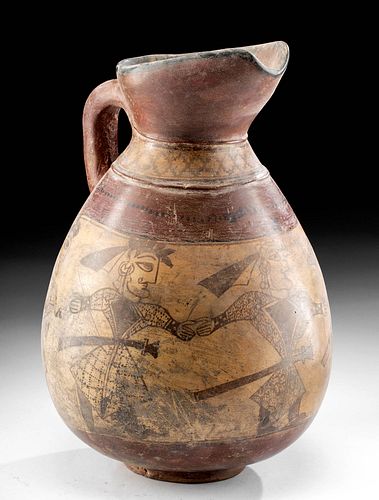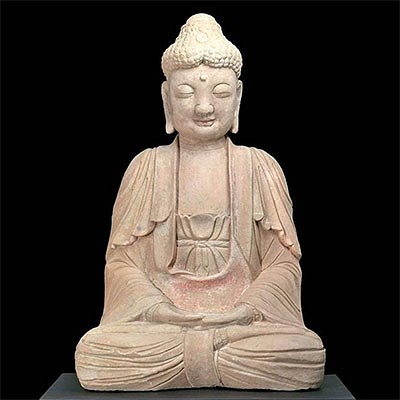12th C. Medieval Ghurid Polychrome Figural Jug, TL'd
Lot 72a
About Seller
Artemis Fine Arts
686 S Taylor Ave, Ste 106
Louisville, CO 80027
United States
Selling antiquities, ancient and ethnographic art online since 1993, Artemis Gallery specializes in Classical Antiquities (Egyptian, Greek, Roman, Near Eastern), Asian, Pre-Columbian, African / Tribal / Oceanographic art. Our extensive inventory includes pottery, stone, metal, wood, glass and textil...Read more
Categories
Estimate:
$4,000 - $6,000
Absentee vs Live bid
Two ways to bid:
- Leave a max absentee bid and the platform will bid on your behalf up to your maximum bid during the live auction.
- Bid live during the auction and your bids will be submitted real-time to the auctioneer.
Bid Increments
| Price | Bid Increment |
|---|---|
| $0 | $25 |
| $300 | $50 |
| $1,000 | $100 |
| $2,000 | $250 |
| $5,000 | $500 |
| $10,000 | $1,000 |
| $20,000 | $2,500 |
| $50,000 | $5,000 |
| $100,000 | $10,000 |
| $200,000 | $20,000 |
About Auction
By Artemis Fine Arts
Feb 18, 2021
Set Reminder
2021-02-18 10:00:00
2021-02-18 10:00:00
America/New_York
Bidsquare
Bidsquare : Exceptional Antiquities, Asian, Ethnographic
https://www.bidsquare.com/auctions/artemis-gallery/exceptional-antiquities-asian-ethnographic-6373
Museum-worthy examples of Egyptian, Greek, Roman, Etruscan, Near Eastern, Far East / Asian, Pre-Columbian, African / Tribal, Oceanic, Native American, Spanish Colonial, Russian, Fossils, Ancient Jewelry, Fine Art, so much more! Artemis Fine Arts info@artemisfinearts.com
Museum-worthy examples of Egyptian, Greek, Roman, Etruscan, Near Eastern, Far East / Asian, Pre-Columbian, African / Tribal, Oceanic, Native American, Spanish Colonial, Russian, Fossils, Ancient Jewelry, Fine Art, so much more! Artemis Fine Arts info@artemisfinearts.com
- Lot Description
Medieval Central Asia, central Afghanistan, Jam in Ghur Province, Ghurid Dynasty, ca. 12th to 13th century CE. A wheel-thrown ceramic pitcher with five well-dressed, right-facing men walking with hands nearly touching as they carry lengthy swords around their waists. The brown-painted figures stride across an orange-brown ground that is enclosed between broad red stripes. Black pigment along the upper body creates stippling within a red band, a latticework pattern within the tapered neck, and outlines the top of the ovoid spout. The bulbous body rests upon a squat, circular foot and is poured via the strap handle on the verso. Size: 6.9" W x 10.25" H (17.5 cm x 26 cm)
Despite scholars knowing little about the Ghurid Dynasty and its artistic stylings, they do know it had a rich heritage and a unique presentation. The area today known as Jam was once called Firuzkuh, the summer capital of the Ghurid sultanate that was destroyed by the Mongols around 1222 to 1223 CE and rediscovered by international researchers in 1957 because of its huge minaret. A wide profusion of different style vessels seem to have been made in medieval Jam during the short Ghurid Dynasty, which enjoyed brief success in the 12th century before collapsing after the death of its most charismatic rulers; indeed, when the Mongols destroyed it, it seems to have already been a city in decline. The pottery made there is all the more remarkable for the brief window in which it was made.
Provenance: private California, USA collection, by descent, moved from Germany in 1997, originally collected in the 1970s in Hamburg, Germany
All items legal to buy/sell under U.S. Statute covering cultural patrimony Code 2600, CHAPTER 14, and are guaranteed to be as described or your money back.
A Certificate of Authenticity will accompany all winning bids.
We ship worldwide and handle all shipping in-house for your convenience.
#155945Minor abrasions to foot, body, spout, and handle, with areas of touch-up painting to handle, and light staining to original colors, otherwise intact and excellent. Light earthen deposits, great remains of original pigment, and nice remaining iconography throughout.Condition
- Shipping Info
-
All shipping is handled in-house for your convenience. Your invoice from Artemis Gallery will include shipping calculation instructions. If in doubt, please inquire BEFORE bidding for estimated shipping costs for individual items.
-
- Buyer's Premium



 EUR
EUR CAD
CAD AUD
AUD GBP
GBP MXN
MXN HKD
HKD CNY
CNY MYR
MYR SEK
SEK SGD
SGD CHF
CHF THB
THB
















